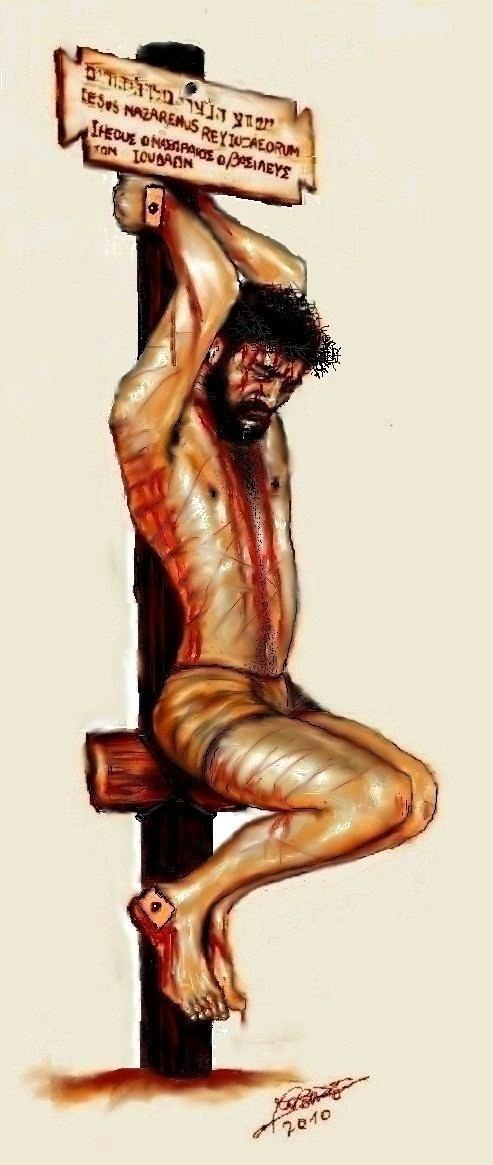 | ||
Stauros (σταυρός) is the Greek word, literally meaning "upright stake" and usually translated as cross, which in the New Testament names the device on which Jesus was executed.
Contents
Etymology
The word stauros comes from the verb ἵστημι (histēmi: "straighten up", "stand"), which in turn comes from the Proto-Indo-European root *stā-, *stha, stao, "stem", "shoot" (the same root from which come the German Stern, or Stamm, the English "stand", the Spanish word estaca, the Portuguese word estaca, the Polish stać, the Italian stare, of similar meanings).
Homeric and classical Greek
In Homeric and classical Greek, until the early 4th century BC, stauros meant an upright stake, pole, or piece of paling, "on which anything might be hung, or which might be used in impaling [fencing in] a piece of ground."
In the literature of that time, it never means two pieces of timber placed across one another at any angle, but always one piece alone.
Koine Greek
In Koine Greek, the form of Greek used between about 300 BC and AD 300, the word σταυρός was used to denote a structure on which Romans executed criminals. In the writings of the Diodorus Siculus (1st century BC), Plutarch and Lucian – non-Christian writers, of whom only Lucian makes clear the shape of the device – the word stauros is generally translated as "cross". This form of capital punishment involved binding the victim with outstretched arms to a crossbeam, or nailing him firmly to it through the wrists; the crossbeam was then raised against an upright shaft and made fast to it about 3 metres from the ground, and the feet were tightly bound or nailed to the upright shaft. Speaking specifically about the σταυρός of Jesus, early Christian writers unanimously suppose it to have had a crossbeam. Thus Justin Martyr said it was prefigured in the Jewish paschal lamb: "That lamb which was commanded to be wholly roasted was a symbol of the suffering of the cross (σταυρός) which Christ would undergo. For the lamb, which is roasted, is roasted and dressed up in the form of the cross (σταυρός). For one spit is transfixed right through from the lower parts up to the head, and one across the back, to which are attached the legs of the lamb."
In A Critical Lexicon and Concordance to The English and Greek New Testament (1877), hyperdispensationalist E. W. Bullinger, in contrast to other authorities, stated: "The σταυρός" (stauros) was simply an upright pale or stake to which Romans nailed those who were thus said to be crucified, σταυρόω, merely means to drive stakes. It never means two pieces of wood joining at any angle. Even the Latin word crux means a mere stake. The initial letter Χ, (chi) of Χριστός, (Christ) was anciently used for His name, until it was displaced by the T, the initial letter of the pagan god Tammuz, about the end of cent. iv." Bullinger's 1877 statement, written before the discovery of thousands of manuscripts in Koine Greek at Oxyrhyncus in Egypt revolutionised understanding of the language of the New Testament, conflicts with the documented fact that, long before the end of the fourth century, the Epistle of Barnabas, which was certainly earlier than 135, and may have been of the 1st century AD, the time when the gospel accounts of the death of Jesus were written, likened the σταυρός to the letter T (the Greek letter tau, which had the numeric value of 300), and to the position assumed by Moses in Exodus 17:11-12. The shape of the σταυρός is likened to that of the letter T also in the final words of Trial in the Court of Vowels among the works of 2nd-century Lucian, and other 2nd-century witnesses to the fact that at that time the σταυρός was envisaged as being cross-shaped and not in the form of a simple pole are given in Dispute about Jesus' execution method.
Modern Greek
In modern Greek the word σταυρός means:
1. (a) "The combination of two beams crossing each other perpendicularly on which Christ was crucified and killed, and by synecdoche any object of that shape; (b) by synecdoche, the sign of the cross as a religious gesture2. (a) a design consisting of two lines crossing perpendicularly and producing four right angles; (b) by synecdoche, a cross-shaped design with various arrangements of the arms3. the ordeals one undergoes in life.Stauros shapes
See also Dispute about Jesus' execution methodA σταυρός (stauros) used either for torture or for execution could be of various shapes. Two are shown here. Others are also possible.
